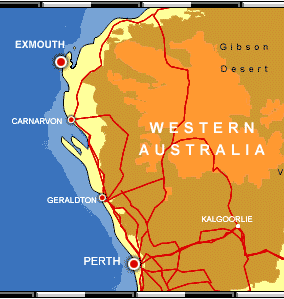EXMOUTH, AUSTRALIA - February 19
(written by Steve)
We are currently sitting outside Exmouth at 9:00am and the Captain has just announced that we will not be tendering in because the swells are too big. So no Exmouth! So that means we will now be at sea for the next 4 days on our way to Manila, Yikes! It’s too bad because this place has some of the nicest beaches and snorkeling in Australia. The population is around 2500 and we have over 3000 people aboard the ship, so basically we would double the population. The town was established in 1967 and was going all out for our arrival as they have never had a cruise ship this size visit them before. The locals had really planned a huge day for us and I am sure very disappointed, as it must have been quite costly for them to do all this. Maybe we will come back on day, but it is a long way from nowhere, so the stop here was really special.
Aboard the Ship we will get our motion patches ready as we are heading back into the Indian Ocean and the heavy seas. A large earth quake was recorded 2 days ago in Indonesia and I don’t know what kinds of swells something like that will produce, but we are all a little nervous because we are going right through those waters. Wish us luck.
Hope everyone is well back home, and say hi to everyone for us, we miss you all!
*****************************************************************************

info retrieved from - http://www.exmouth-australia.com/
The first recorded landing in the area was by the Dutch Captain Jacobz of the Mauritius in 1618. Australian Captain Phillip Parker King later visited in 1818 and named the peninsula North West Cape, and also named Exmouth Gulf after a British Royal Naval Officer. In the subsequent years Pearl Luggers visited the area from Broome and during World War II the area became important for a military operation named ”Operation Potshot”. During the 1950’s the area was also known for fishing, pastoral leases and oil exploration. In 1967 Australia and the US established a communications base in the area and in the same year the town of Exmouth was gazetted as the supporting town to the base. The landing of the schooner ”Maud” in 1884 is the earliest recorded European activity in the Coral Bay area. This area is slightly north of the township of Coral Bay and is known as Maud’s Landing. In 1896 a town site reserve was gazetted but it wasn’t until 1915 that Maud’s Landing was officially proclaimed a town. Three kilometres to the south, an area known as Bill’s Bay was becoming very popular with locals and adventurous travellers. In 1968 formal settlement began with the establishment of a hotel, caravan park and service station. The hotel was named the Coral Bay Hotel in reference to the beautiful coral reef in the bay area. Subsequently the settlement became known as Coral Bay. Today the township survives solely on tourism.
If it’s pristine beaches you’re after you have come to the right place! The Exmouth coastline offers visitors an endless array of stunning, unspoilt, deserted beaches which cater to everyone’s needs: snorkelling, sunbathing, watersports & fishing... Town Beach The closest beach to Exmouth is Town Beach. Located only 1 km from the Exmouth townsite this beach is ideal for morning walks and beachcombing. Town Beach also provides a 4WD access track down to the beach. Bundegi Beach Located 12 km north of Exmouth is Bundegi Beach. This beach marks the start of the Ningaloo Marine Park and is a great beach for swimming, snorkelling and fishing. A coral viewing boat departs from here and there is a kiosk adjacent to the jetty. There is a boat launching facility at the southern end of the beach. Lighthouse Bay Access tracks along the Mildura Wreck Road into Lighthouse Bay provide entrance to a variety of beaches suitable for fishing, surfing, swimming and sunbathing. At the end of the road you will discover the wreck of the SS Mildura. From the beach you can view the wreck, a cattle ship that was carrying Kimberleycattle to the south. It was destroyed when it clipped the reef during a cyclone in 1907. No lives were lost. Timbers and irons were salvaged and used in renovations for Yardie Homestead. The hull sat on the reef undisturbed until World War II when allied planes used it for bombing